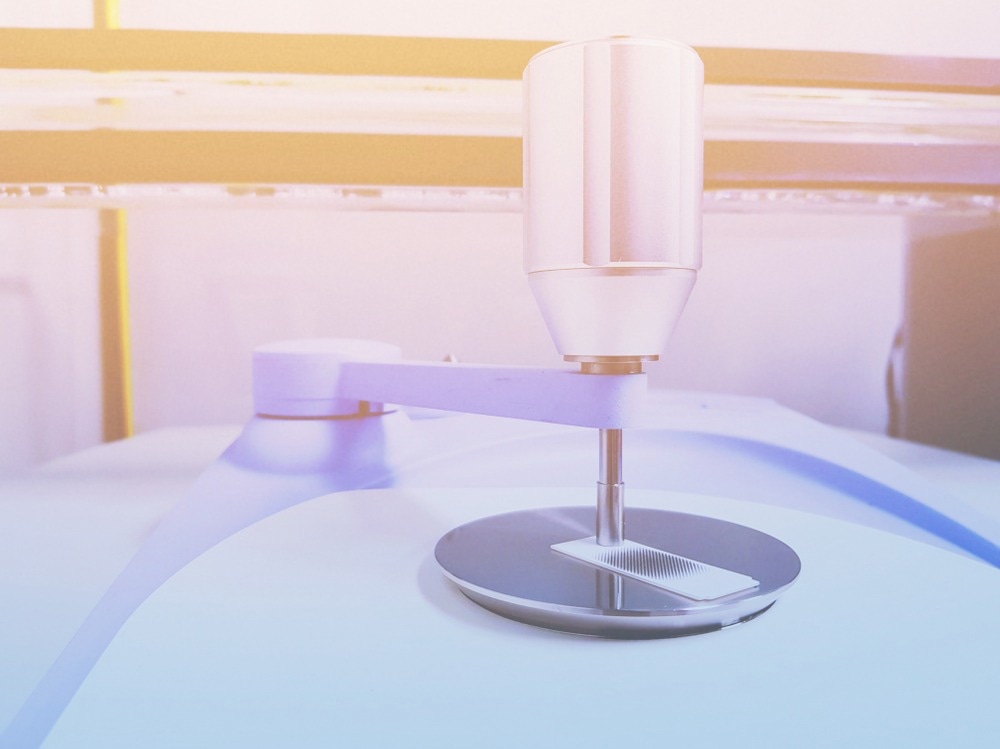 By Owais AliReviewed by Lexie CornerApr 26 2024
By Owais AliReviewed by Lexie CornerApr 26 2024The demand for functional foods rich in bioactive compounds like vitamins, phenolics, and anthocyanins has recently grown due to their health benefits beyond basic nutrition. However, traditional methods for analyzing these compounds in food products are often costly and time-consuming, requiring extensive sample preparation and skilled personnel.

Image Credit: Ken stocker/Shutterstock.com
Infrared (IR) spectroscopy has emerged as a rapid, real-time, cost-effective, and environmentally friendly solution for analyzing bioactive compounds, enhancing food quality assessment and sustainability.
The Fundamentals of IR Spectroscopy
IR operates on the principle that molecules absorb specific IR light frequencies corresponding to their chemical bonds' vibrations. This absorption spectrum can be measured to provide detailed information about a sample's molecular structure and composition.
The spectrum of IR radiation is categorized into three primary regions critical to analytical applications: mid-infrared (MIR; 4000–400 cm-1), near-infrared (NIR; 750–2500 nm), and far-infrared (FIR; 400–10 cm-1)—the latter is less commonly used in food analysis. Each region is pivotal for its unique absorption characteristics, which are manipulated to decipher the molecular compositions of samples.1
NIR spectroscopy, for instance, measures combination and overtone bands of infrared-active bonds, making it ideal for rapidly analyzing food macroconstituents. MIR spectroscopy, on the other hand, provides detailed insights into the molecular structure through its sensitivity to functional groups within a sample, such as C=O or NH2 groups, offering a 'fingerprint' of the molecule.
NIR and MIR spectroscopy provide numerous benefits over traditional methods: they are highly sensitive, require only small sample sizes, and can analyze bioactive compounds in various states, including solids, gels, powders, gases, and liquids.1,2
Case Studies and Applications
Quantifying Nutritional and Anti-Nutritional Bioactive Compounds in Faba Beans
Faba (or fava) beans (Vicia faba L.) are valued for their nutritional richness, containing high levels of antioxidants and phenolic compounds. However, they also contain anti-nutritional factors like vicine and convicine, which can diminish their health benefits. The quantification of these compounds is important, but traditional analytical methods prove time-consuming and costly.
A study published in Legume Science investigated the potential of IR spectroscopy, particularly MIR spectroscopy (MIRS) and NIR spectroscopy (NIRS), as rapid and non-invasive techniques for analyzing bioactive and anti-nutritional compounds in faba bean flour.
NIRS demonstrated potential in predicting total phenolic content and ferric-reducing antioxidant power, albeit with moderate precision (R2pred of 0.66 and 0.59, respectively, and RMSEP of 76 and 87 mg/100 g, respectively).
It also demonstrated satisfactory performance in predicting protein content (R2pred of 0.86 and RMSEP of 0.35 %). However, MIRS did not yield suitable models for the compounds investigated, likely due to reproducibility issues.
The researchers suggest that while NIRS could serve as a rapid screening tool for distinguishing high and low levels of phenolics and antioxidants in faba beans, further optimization is required for precise quantification.3
Analyzing Bioactive Compound Changes during Kefir Fermentation
Fruits like strawberries are rich sources of healthy antioxidants, including phenolic compounds, anthocyanins, and carotenoids. Fermenting these fruits into beverages like water kefir extends their shelf life and enhances their nutritional value.
However, traditional methods, such as chromatography, commonly employed for evaluating the composition of fermented beverages, are often time-consuming and expensive.
A study published in LWT employed MIR spectroscopy coupled with chemometrics to develop calibration models for estimating bioactive antioxidants, anthocyanins, and phenolic compounds in a strawberry juice fermented with water kefir grains.
Mid-IR fermentation spectra samples were analyzed at different time points, and predictive models were constructed using partial least squares (PLS) regression.
Principal component analysis (PCA) revealed distinct chemical changes during fermentation, while PLS regression models demonstrated good predictive ability, with determination coefficients (R2) ranging from 0.74 to 0.89. The best prediction was for total anthocyanins, with a root mean square error of prediction of 0.18 and a residual predictive deviation (RPD) of 3.11.
This highlights the feasibility of using chemometrics and MIR spectroscopy for rapid and non-destructive analysis of bioactive compounds during kefir fermentation, offering insights into the fermentation process and potential health benefits of the beverage.4
Investigating Bioactive Phenolic Compounds in Olive Oil
Olive oil, rich in unique bioactive compounds like carotenoids, tocopherols, chlorophylls, and phenolic compounds, offers potential health benefits due to its high levels of natural antioxidants, particularly phenolic compounds, which are exclusive to this oil.5
A study published in the European Journal of Lipid Science and Technology used MIR and NIR spectroscopy to analyze polar phenolic compounds in olive oil and their effect on oil quality.
The researchers developed satisfactory multivariate validation algorithms for total polar phenolic compounds (r = 0.91), hydroxytyrosol (r = 0.91), and tyrosol secoiridoid (r = 0.92) derivatives using NIR spectroscopy.
However, chemometric analysis of MIR spectra yielded unsatisfactory validation models (r = 0.54, 0.43, and 0.66 for tyrosol secoiridoid, hydroxytyrosol, and total polar phenolic) despite MIR calibration algorithms showing higher correlations than NIR (r > 0.96 for phenolics).
These findings demonstrate that NIRS is highly valuable for rapid analysis of virgin olive oil samples, estimating polar phenolic profiles, and providing real-time composition data for automatic processing control.6
Challenges and Limitations
Despite its many benefits, the application of IR spectroscopy in bioactive compound analysis faces challenges. One major obstacle is the interpretation of spectra from complex mixtures, necessitating robust calibration models for accurate quantitative analysis across diverse sample populations.
IR spectroscopy, especially NIRS, is predominantly effective for analyzing macroconstituents at concentrations around 0.5 % or higher. Below this concentration, it becomes difficult to separate the analyte's signal from other spectral peaks.
In some cases, IR spectroscopy may detect a different analyte at macro-levels that correlates with the targeted analyte, a phenomenon referred to as a secondary or surrogate correlation.
Regardless of these limitations, the inherent advantages of IR spectroscopy—such as its cost-effectiveness and rapid analysis capability—continue to make it an invaluable tool across various food industry sectors.1
The Future of IR Spectroscopy in Food Analysis
Promising advancements and expanding applications mark the future of IR spectroscopy in food analysis.
Technological developments like hyperspectral imaging are revolutionizing the field by enabling precise quantification and spatial analysis of bioactive compounds. This technique has proven effective for analyzing anthocyanins and phenolics in diverse food products like grapes and coffee beans.
NIRS is also increasingly adopted in online real-time process analytics within food manufacturing, primarily for monitoring quality parameters like moisture and protein content.1
More from AZoOptics: Advances in Spatial Light Modulation for Enhanced Holographic Data Processing
References and Further Reading
- Johnson, JB., Walsh, KB., Naiker, M., Ameer, K. (2023). The use of infrared spectroscopy for the quantification of bioactive compounds in food: A review. Molecules. doi.org/10.3390/molecules28073215
- Mishra, M. (2022). Spectroscopic techniques for the analysis of food quality, chemistry, and function. Advanced Spectroscopic Techniques for Food Quality. doi.org/10.1039/9781839165849-00001
- Johnson, JB., Walsh, KB., Naiker, M. (2023). Assessment of bioactive compounds in faba bean using infrared spectroscopy. Legume Science. doi.org/10.1002/leg3.203
- da Silva Araújo, C., Macedo, LL., Teixeira, LJQ. (2023). Use of mid-infrared spectroscopy to predict the content of bioactive compounds of a new non-dairy beverage fermented with water kefir. LWT. doi.org/10.1016/j.lwt.2023.114514
- Durazzo, A., Lucarini, M., Kiefer, J., Mahesar, S. A. (2020). State-of-the-art infrared applications in drugs, dietary supplements, and nutraceuticals. Journal of Spectroscopy. doi.org/10.1155/2019/5319024
- Mora‐Ruiz, ME., Reboredo‐Rodríguez, P., Salvador, MD., González‐Barreiro, C., Cancho‐Grande, B., Simal‐Gándara, J., Fregapane, G. (2017). Assessment of polar phenolic compounds of virgin olive oil by NIR and mid‐IR spectroscopy and their impact on quality. European Journal of Lipid Science and Technology. doi.org/10.1002/ejlt.201600099
Disclaimer: The views expressed here are those of the author expressed in their private capacity and do not necessarily represent the views of AZoM.com Limited T/A AZoNetwork the owner and operator of this website. This disclaimer forms part of the Terms and conditions of use of this website.